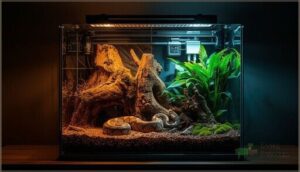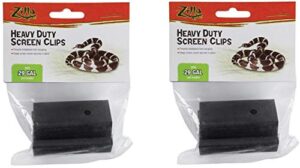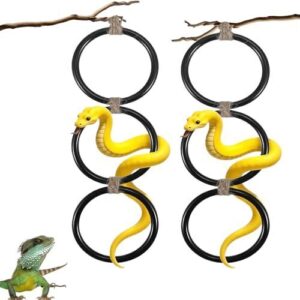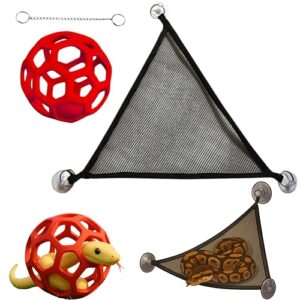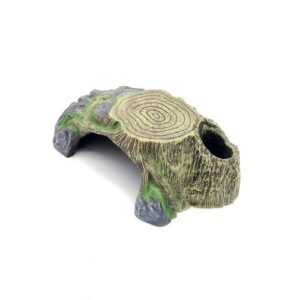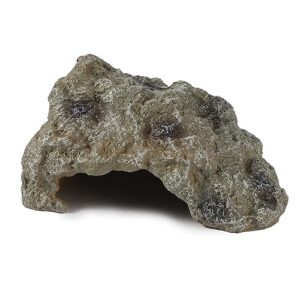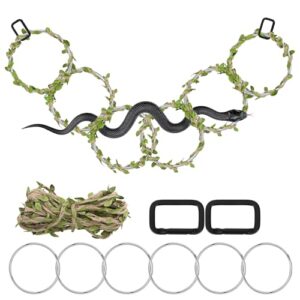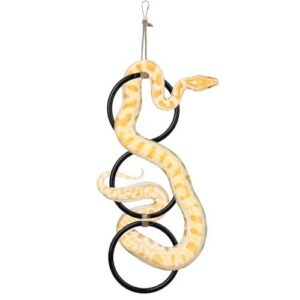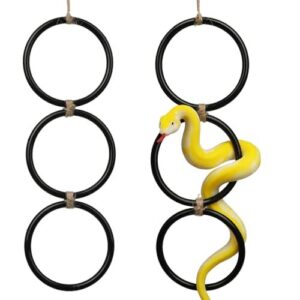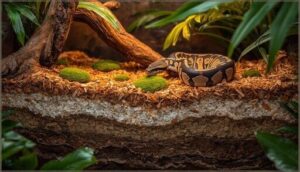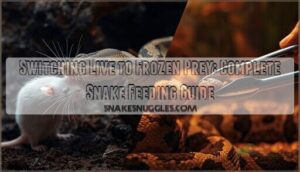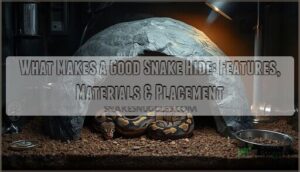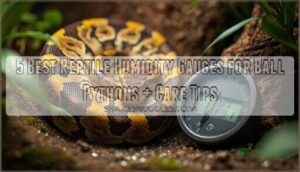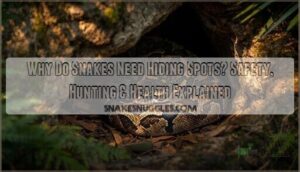This site is supported by our readers. We may earn a commission, at no cost to you, if you purchase through links.
Your snake’s enclosure isn’t just a box—it’s the entire world your pet experiences every single day. Most respiratory infections and failed sheds trace back to one issue: improper housing accessories. You need the right thermal gradient tools, humidity controls, and hiding spots to prevent stress-related illness.
Poor setups lead to escape attempts, feeding refusal, and behavior problems that owners mistake for temperament issues. The difference between a thriving snake and a struggling one often comes down to five essential accessories. These products create secure zones, proper airflow, and species-appropriate microclimates.
You’ll find climbing rings for arboreal species, rock caves for ground dwellers, and screen clips that actually prevent escapes. Each accessory fulfills a specific health purpose beyond decoration.
Table Of Contents
- Key Takeaways
- Essential Snake Housing Accessories
- Top 10 Snake Housing Accessories Reviewed
- 1. Zilla Reptile Terrarium Screen Clips
- 2. Snake Climbing Ring Accessory
- 3. Snake Enrichment Hammock And Toy Ball Set
- 4. Snake Climbing Rings for Ball Pythons
- 5. Reptile Cave Hide House
- 6. IBWell Reptile Rock Hide Cave
- 7. Duseu Snake Climbing Rings
- 8. Snake Climbing Enrichment Rings Toy
- 9. Nuburbur Snake Climbing Rings
- 10. Snake Climbing Rings for Reptile Tanks
- Choosing The Best Substrate and Bedding
- Creating a Stimulating Snake Environment
- Maintenance Tips for Snake Housing Accessories
- Frequently Asked Questions (FAQs)
- Where can I buy a reptile cage & Snake rack?
- What are the different types of snake cage accessories?
- What makes a good snake enclosure?
- Where can I find the best reptile enclosures?
- What is the ideal temperature for a snakes habitat?
- How often should I clean my snakes terrarium accessories?
- Can I use live plants in my snakes enclosure?
- What type of lighting is best for a snakes habitat?
- How do I maintain proper humidity levels in my snakes terrarium?
- How often should snake enclosures be cleaned?
- Conclusion
Key Takeaways
- Your snake’s health depends on proper housing accessories that create thermal gradients, control humidity, and provide secure hiding spots—most respiratory infections and shedding problems trace back to poor enclosure setup.
- Essential accessories like screen clips, climbing rings, and species-appropriate hides serve specific health purposes beyond decoration, preventing escape attempts, feeding refusal, and stress-related illness.
- Substrate choice directly impacts your snake’s humidity needs and burrowing behavior—cypress mulch works for tropical species while aspen shavings suit drier setups, but both require matching to your specific snake’s requirements.
- Regular maintenance matters as much as initial setup—clean accessories every 2-4 weeks with reptile-safe disinfectants, inspect for wear weekly, and rotate enrichment items to keep your snake engaged and prevent bacterial buildup.
Essential Snake Housing Accessories
Your snake’s home isn’t complete without the right accessories. The foundation starts with selecting pieces that prioritize safety, comfort, and natural behavior patterns.
Below, you’ll find essential accessories that create a functional and enriching environment for your snake.
Importance of Proper Snake Housing
Your snake’s housing isn’t just a box—it’s the foundation of their health. Research shows snakes in proper enclosures have fewer health issues and exhibit more natural behaviors. Getting housing right means:
Proper snake housing is the key to their health, reducing illness and encouraging natural behaviors
- Adequate space (at least one body length) reduces stress and illness
- Correct thermal gradients prevent respiratory disease and aid digestion
- Proper humidity control stops skin infections and shedding problems
Snake welfare depends on species-specific terrarium design and bioactive enclosures that support natural behaviors. Ensuring proper snake housing conditions is essential for the health and well-being of pet snakes.
Key Features to Look For
When shopping for reptile enclosure accessories, prioritize these must-haves: thermal gradients with dedicated heating zones, humidity control through proper substrate and monitoring tools, and secure ventilation that prevents escapes. Your snake terrariums need non-toxic materials free from sharp edges.
A well-designed snake hide with smooth entry points helps your pet feel secure while reducing stress during shedding cycles.
Spatial layout matters—guarantee enough floor space for water bowls, hides, and movement. Bioactive enclosures benefit from terrarium design that facilitates natural behaviors while maintaining temperature zones.
Reptile owners should research reptile enclosure materials to make informed decisions about their snake’s habitat.
Safety and Comfort Considerations
Beyond selecting quality reptile accessories, your snake habitat must actively prevent injury and minimize stress. Research shows that proper thermal gradients paired with strategically placed snake hides reduce anxiety-related behaviors. Here’s what matters most:
Choosing the right snake habitat accessories like climbing structures and hammocks can promote natural behaviors while keeping your pet secure and comfortable.
- Enclosure security – Secure lids prevent escapes and associated injuries
- Humidity control – Maintain species-appropriate levels using monitoring tools
- Multiple hides – Place them across temperature zones for stress reduction
- Smooth surfaces – Eliminate sharp edges in all terrarium decoration
Top 10 Snake Housing Accessories Reviewed
You need the right accessories to keep your snake healthy and engaged. The products below cover everything from security hides to climbing enrichment.
Proper snake hide placement helps reduce stress and creates a comfortable space where your pet feels secure.
Each option meets specific habitat needs that matter for your snake’s wellbeing.
For example, building a proper python enclosure requires smooth surfaces and secure materials that won’t splinter or crack under heat.
1. Zilla Reptile Terrarium Screen Clips
Your tank’s secure seal matters more than you think. The Zilla Reptile Terrarium Screen Clips keep your snake safely inside with heavy-duty spring steel construction. These small clips fit tanks up to 29 gallons and snap onto your terrarium rim for reliable screen security.
You’ll get four clips total (two 2-packs) at roughly $0.09 per kilogram package weight. They prevent reptile escape through simple clip installation. Some patience helps during your first setup, and occasional rebending maintains proper tension on your reptile enclosure over time.
| Best For | Reptile owners with small to medium tanks (up to 29 gallons) who need reliable screen clips to prevent escapes from snakes, geckos, and other climbing species. |
|---|---|
| Primary Material | Metal/Screen |
| Installation Method | Clip-on |
| Target Species | All reptiles |
| Safety Feature | Secure clips |
| Primary Function | Security/escape prevention |
| Ease of Cleaning | Easy |
| Additional Features |
|
- Heavy-duty spring steel construction provides a secure, long-lasting grip that won’t break under normal use
- Simple snap-on installation makes setup quick and easy, even for first-time reptile keepers
- Great value at 4 clips total (two 2-packs) that work well on various glass terrariums
- Takes some practice to figure out the right technique for clipping on and removing them
- May need occasional rebending to maintain proper tension over time
- Small size means they won’t fit larger tanks over 29 gallons
2. Snake Climbing Ring Accessory
Your snake’s need to climb doesn’t disappear just because it’s indoors. The Snake Climbing Ring Accessory brings vertical space and arboreal stimulation right into your reptile enclosure.
At $7.99, you get three interlocking black ABS rings measuring 17.1 x 4.5 inches total. This animal enclosure accessory promotes reptile exercise through natural weaving behavior. Ball pythons and corn snakes use these climbing ring designs for muscle toning.
These rings work great alongside other snake enclosure building elements like branches and hides to create an active, enriching habitat.
Installation requires jewelry wire for secure terrarium and vivarium design. The modular setup enables snake habitat creation with adjustable difficulty levels for ongoing snake enrichment.
| Best For | Snake owners who want to add vertical climbing enrichment to their enclosure, especially for ball pythons, corn snakes, and other semi-arboreal species up to 5 feet long. |
|---|---|
| Primary Material | ABS Plastic |
| Installation Method | Hook attachment |
| Target Species | Climbing snakes |
| Safety Feature | Smooth edges |
| Primary Function | Climbing enrichment |
| Ease of Cleaning | Easy |
| Additional Features |
|
- Triple interlocking ring design gives your snake multiple paths to climb and weave through, encouraging natural exploration and muscle toning
- Affordable at $7.99 and easy to reposition, so you can change up the enclosure layout without breaking the bank
- Smooth ABS plastic surface is simple to wipe down and disinfect during routine tank cleaning
- You’ll need to buy jewelry wire separately since it doesn’t come with everything needed for installation
- The 4.5-inch ring diameter won’t work for very large constrictors or particularly small snakes that might get stuck
- Hanging setup requires a mesh-top enclosure or extra suction cups, so it’s not a universal fit for all tank styles
3. Snake Enrichment Hammock And Toy Ball Set
Vertical space transforms how your snake interacts with its world. The Snake Enrichment Hammock And Toy Ball Set delivers dual-function reptile stimulation at $14.99. You get a breathable mesh hammock with suction cups and a jungle gym ball on a secure chain.
This red nylon accessory fits small ball pythons and corn snakes. The hammock creates elevated lounging space near heat sources for behavioral thermoregulation. The toy ball encourages snake climbing and tactile exploration during supervised sessions. Hammock materials resist moisture buildup when properly disinfected. Always check toy ball safety—size prevents swallowing risks in species-appropriate setups.
| Best For | Snake owners looking to add vertical climbing space and interactive enrichment for small ball pythons, corn snakes, or similarly sized reptiles. |
|---|---|
| Primary Material | Nylon/Mesh |
| Installation Method | Suction cups |
| Target Species | Small pythons/snakes |
| Safety Feature | Secure chain |
| Primary Function | Exercise/lounging |
| Ease of Cleaning | Moderate |
| Additional Features |
|
- Hammock provides elevated basking spots near heat lamps, helping snakes regulate their body temperature naturally
- Dual-function design combines climbing exercise with tactile exploration through the ball accessory
- Affordable at $14.99 for both hammock and toy components in one set
- Suction cups may fail on textured or porous terrarium surfaces, requiring frequent reinstallation checks
- Ball may arrive flattened or lose shape quickly with regular use
- Not suitable for larger or heavier snake species that exceed the weight capacity of the mounting system
4. Snake Climbing Rings for Ball Pythons
Enrichment rings release your ball python’s natural climbing behavior without sacrificing floor space. Snake Climbing Rings for Ball Pythons feature food-grade acrylic construction with 4.33-inch diameter openings. These vertical space accessories hold up to 5 lbs and install via chains or wire from your terrarium ceiling.
Smooth surfaces prevent scale damage during exploration. Ring sizing suits juvenile and subadult ball pythons—your snake accesses elevated areas while you maintain proper reptile enclosure enrichment.
Research shows climbing branches and rings improve problem-solving skills in captive snakes. This climbing ring safety fosters healthy muscle development.
| Best For | Ball python owners looking to add vertical enrichment to their enclosure without taking up valuable floor space, especially for juvenile and subadult snakes. |
|---|---|
| Primary Material | Acrylic |
| Installation Method | Hook/hanging |
| Target Species | Ball pythons |
| Safety Feature | Smooth surface |
| Primary Function | Climbing/enrichment |
| Ease of Cleaning | Easy |
| Additional Features |
|
- Food-grade acrylic construction with smooth surfaces prevents scale damage while your snake explores and climbs
- Supports up to 5 lbs and installs easily from the ceiling using chains or wire, maximizing vertical space
- Research-backed enrichment that improves problem-solving skills and promotes healthy muscle development in captive snakes
- Ring diameter may not accommodate very large adult ball pythons as they grow
- Hanging system can be tricky to secure on mesh-top enclosures without additional hardware
- Some snakes may outgrow the 4.33-inch rings within a year, requiring larger alternatives
5. Reptile Cave Hide House
Your snake’s stress levels drop when it finds the perfect sanctuary. Reptile Cave Hide House delivers a naturalistic rock appearance in a multicolor finish at 6.6 x 4 x 2.2 inches. This hide material’s choice suits small snakes, frogs, and turtles while promoting reptile wellness through secure retreat spaces.
The wide entrance accommodates shedding cycles and egg-laying behavior. Stable construction prevents tipping during snake behavior patterns like burrowing. You’ll maintain clean reptile enclosures easier with this modern cave design—it’s essential among reptile accessories and products for proper animal enclosures and daily reptile care routines.
| Best For | Small reptile owners looking for a natural-looking hide that provides a secure spot for shedding, hiding, and egg-laying without taking up too much space. |
|---|---|
| Primary Material | Rock/Resin |
| Installation Method | Place inside |
| Target Species | Small reptiles |
| Safety Feature | Stable design |
| Primary Function | Hiding/shelter |
| Ease of Cleaning | Easy |
| Additional Features |
|
- Naturalistic rock design blends into terrariums while giving reptiles the privacy they need to feel safe and reduce stress
- Weighted and stable construction prevents tipping when your snake or lizard moves around inside
- Easy to clean and works well for multiple species including small snakes, frogs, toads, and turtles
- Size limits this to smaller reptiles—won’t work for adult ball pythons or larger species
- Wide entrance might not provide enough security for shy snakes that prefer tighter, more enclosed spaces
- Entrance dimensions aren’t adjustable, so it might not fit the ideal sizing recommendations for all snake types
6. IBWell Reptile Rock Hide Cave
Your reptile’s security starts with the right shelter. IBWell Reptile Rock Hide Cave measures 5.91″D x 8.46″W x 12″H in non-toxic resin for safe reptile enclosures.
This rock cave design provides single-entrance security that reduces stress in ball pythons and leopard geckos. The smooth interior makes reptile care and housing easier—you’ll clean animal enclosure accessories quickly between deep cleaning cycles.
Snake shelter selection matters for proper hides, and this cave’s textured exterior assists shedding while maintaining reptile hiding spaces essential for snake care routines.
| Best For | Small to medium reptile owners who need a natural-looking hide that’s easy to clean and works in both humid and dry setups. |
|---|---|
| Primary Material | Resin |
| Installation Method | Place inside |
| Target Species | Ball pythons/geckos |
| Safety Feature | Smooth edges |
| Primary Function | Hiding/shelter |
| Ease of Cleaning | Easy |
| Additional Features |
|
- Non-toxic resin construction with smooth edges makes it safe for sensitive reptile skin and simple to disinfect between deep cleans.
- Single-entrance design with full overhead cover provides the security snakes and lizards naturally seek when they need to destress.
- Textured exterior doubles as a shedding aid while the rock-style appearance blends into naturalistic terrarium layouts.
- Thick resin walls reduce interior space compared to external dimensions, which may not accommodate larger or fast-growing reptiles.
- Some users report sizing inconsistencies between advertised measurements and actual product dimensions upon delivery.
- Single smaller size option means you’ll need to upgrade hides as juvenile reptiles mature into adults.
7. Duseu Snake Climbing Rings
Your ball python needs more than floor space—it craves height. Duseu Snake Climbing Rings cost $9.99 and feature sturdy wooden core construction with natural jute rope for vertical space exploration in reptile enclosures.
This ring design promotes snake climbing while encouraging natural behaviors that reduce stress. The pet-safe materials and smooth wooden rings guarantee climbing safety during animal enclosure accessories setup.
You’ll attach these rings easily using included metal hooks for snake enrichment. The flexible reptile habitat layout adjusts to various snake care routines and pet care and maintenance schedules.
| Best For | Snake owners looking for an affordable way to add vertical climbing space and enrichment to their reptile enclosure. |
|---|---|
| Primary Material | Wood/Jute |
| Installation Method | Hook attachment |
| Target Species | Ball pythons/snakes |
| Safety Feature | Smooth rings |
| Primary Function | Climbing/exploration |
| Ease of Cleaning | Moderate |
| Additional Features |
|
- Affordable at $9.99 with sturdy wooden and natural jute construction
- Encourages natural climbing behaviors that reduce stress and repetitive movements
- Easy to install with included metal hooks and adjustable for different enclosure layouts
- Large gaps in the jute may not work well for very young or thin snakes
- Carabiner clip might not support heavier or larger adult snakes
- Ring size may be too small for bigger juvenile or adult snakes
8. Snake Climbing Enrichment Rings Toy
With a 4.8-star rating across 70+ reviews, these stainless steel rings cost around $25 and bring lasting Vertical Space for Snake Enrichment. You’ll get 20 inches of Climbing Ring Safety with 360° smooth edges protecting your pet’s belly scales.
The included 98.5-inch artificial vine creates naturalistic Reptile Habitat appeal during Toy Installation.
This Environmental Enrichment setup fosters healthy Snake Behavior and Enrichment across species—from ball pythons to geckos. Reptile Exercise becomes routine as your snake explores upward through Reptile Enclosures, transforming Pet Care and Maintenance into active engagement.
| Best For | Snake owners who want to add vertical climbing space to their enclosure and encourage natural exercise behaviors in ball pythons, corn snakes, and similar medium-sized species. |
|---|---|
| Primary Material | Stainless Steel |
| Installation Method | Hook attachment |
| Target Species | Multiple species |
| Safety Feature | 360° safe edges |
| Primary Function | Climbing/decoration |
| Ease of Cleaning | Easy |
| Additional Features |
|
- Durable stainless steel construction with smooth, 360° safe edges that won’t scratch or damage your snake’s belly scales during climbing
- Includes a generous 98.5-inch artificial vine to wrap the rings and create a realistic jungle look that blends into naturalistic setups
- High customer satisfaction with 4.8 stars across 70 reviews, with owners reporting their snakes actively use and enjoy the rings
- Assembly takes time and patience—wrapping the long vine around the rings can be tedious and somewhat frustrating
- May require additional hardware for secure attachment depending on your cage type, especially for mesh-top terrariums
- Installation and customization require some trial and error to get the positioning and height just right for your specific enclosure
9. Nuburbur Snake Climbing Rings
Nuburbur’s acrylic rings deliver premium Climbing Ring Safety with harmless, waterproof material and rounded edges that protect delicate scales. At 4 inches per ring and 16.5 inches total, this install-free Climbing Structure tests to 30 pounds and creates instant Environmental Stimulation in your Terrarium.
The sisal-wrapped joints provide grip for ball pythons and corn snakes exploring their Reptile Playground. You’ll maintain a hygienic Reptile Enclosure through easy cleaning, supporting healthy Snake Behavior and Enrichment.
Pet Care becomes simpler when your Reptile Keeping setup encourages natural movement without constant rearrangement.
| Best For | Ball python and corn snake owners looking for a safe, easy-to-clean climbing structure that encourages natural exploration without complicated installation. |
|---|---|
| Primary Material | Acrylic |
| Installation Method | Hook attachment |
| Target Species | Ball pythons/snakes |
| Safety Feature | Rounded edges |
| Primary Function | Climbing/enrichment |
| Ease of Cleaning | Easy |
| Additional Features |
|
- Smooth acrylic design with rounded edges protects your snake’s scales during climbing and rubbing, while the waterproof material wipes clean in seconds
- Handles up to 30 pounds with reinforced sisal rope at connection points, giving you confidence even as your snake grows
- Hook-and-hang setup takes under a minute—no drilling, no tools, just attach to your mesh lid and you’re done
- The 4-inch ring diameter might feel cramped for larger adult snakes or too roomy for hatchlings, limiting which life stages can use it comfortably
- Sisal rope can fray or collect waste over time, so you’ll need to inspect it regularly and possibly replace the rings sooner than solid plastic alternatives
- Snakes may lose interest after a few weeks if you don’t rotate it with other enrichment items, since the fixed ring layout doesn’t change on its own
10. Snake Climbing Rings for Reptile Tanks
You’ll find 4.6-inch ABS rings at $9.99 per two-pack that optimize Vertical Space in your Terrarium through modular design. These Climbing Structures attach to mesh lids with distributor hardware, spreading load across screens in Reptile Enclosures up to 18 inches tall.
Rounded edges maintain Climbing Ring Safety while promoting Snake Exercise through ball pythons and corn snakes. The Vivarium setup assists Reptile Enrichment without drilling, letting you customize climbing paths.
Pet Care simplifies when Reptile Keeping accessories encourage natural exploration through secure, species-appropriate pathways.
| Best For | Snake owners looking to add affordable vertical enrichment to their terrariums, especially those keeping ball pythons, corn snakes, or similar medium-sized climbing species. |
|---|---|
| Primary Material | ABS Plastic |
| Installation Method | Hook attachment |
| Target Species | Ball pythons/snakes |
| Safety Feature | Rounded edges |
| Primary Function | Climbing/enrichment |
| Ease of Cleaning | Easy |
| Additional Features |
|
- At $9.99 for two rings with a 4.6-inch diameter, they’re an affordable way to add climbing opportunities without breaking the bank.
- The rounded ABS plastic edges and smooth construction help prevent scale damage or injuries while your snake explores.
- Easy installation with included hooks that work with standard mesh lids, no drilling or permanent modifications needed.
- Some customers have reported quality control issues, including receiving only one ring instead of the advertised two per pack.
- Won’t work well for very large or heavy snakes that might exceed the weight capacity of the rings or hanging hardware.
- Limited mounting options mean you’ll need a compatible mesh lid or screen top, which might not work for all enclosure types.
Choosing The Best Substrate and Bedding
Your snake’s substrate isn’t just bedding—it’s the foundation of their entire habitat. The right choice affects humidity levels, burrowing behavior, and overall health.
Let’s look at what works best for different species and setups.
Natural Vs. Synthetic Bedding Options
You’ll face two main substrate paths: natural and synthetic. Natural bedding like cypress mulch holds moisture well, supporting species that need higher humidity. Aspen shavings offer moderate density with low dust.
Synthetic substrates reduce parasite risk and simplify cleaning, though they may need extra misting.
Choose based on your snake’s moisture needs and your maintenance style. Both work when matched to species requirements and terrarium conditions.
Humidity Control and Substrate Selection
Matching substrate options to your snake’s humidity needs prevents shedding issues and respiratory stress. Moisture control starts with choosing the right base layer and monitoring levels daily.
- Cypress mulch holds moisture for tropical species needing 50%–70% humidity
- Coconut husk retains water without becoming waterlogged in bioactive ecosystems
- Paper bedding dries quickly, reducing mold in reptile enclosures for corn snakes
- Sphagnum moss boosts local humidity near hides during shedding cycles
- Digital hygrometers track environmental balance at terrarium height for snake hydration
Safe Materials for Snake Health
Your snake’s health depends on keeping toxic material risks out of reptile enclosures. Choose reptile-safe plastics and non-toxic finishes free of heavy metals. Inert substrates like untreated wood and food-grade silicone support bioactive substrate systems while protecting animal health and wellness. Avoid cedar, pressure-treated lumber, and synthetic foams in snake cages.
| Material Type | Safe Options | Avoid |
|---|---|---|
| Wood & Hides | Untreated cork, natural stone | Cedar, treated lumber |
| Plastic & Coatings | BPA-free, reptile-certified | Copper, zinc hardware |
| Chemical Free Decor | Food-grade silicone | Solvent-based adhesives |
Prioritize chemical-free decor with documented certifications to maintain reptile health long-term.
Creating a Stimulating Snake Environment
Your snake needs more than just food and water to thrive. A well-designed environment with the right accessories keeps your pet active, curious, and healthy.
Let’s look at what makes a snake enclosure truly enriching.
Enrichment Accessories and Their Benefits
Your snake’s well-being depends on environmental enrichment that sparks natural behaviors. Sensorial stimulation through naturalistic decor like leaves and textured surfaces encourages exploration, while climbing structures support muscle development.
Behavioral modification happens when you rotate items regularly—think Penn Plax Lizard Lounger for basking spots. Don’t forget lid locks for safety.
Hammocks, hides, and varied textures keep your snake engaged and stress-free.
Hides, Hammocks, and Climbing Features
Your snake needs refuge options that match its body size—think Zen Den Snake Hide or Zen Corner Cave for full concealment with the head exposed.
Hammock safety starts with secure attachment and regular fabric checks to prevent tears. Climbing structures like rings promote muscle development when positioned vertically.
Pair these with a Penn Plax Lizard Lounger and terrarium kit essentials for complete environmental enrichment.
Naturalistic Decor and Sensory Stimulation
Think of your enclosure as a forest floor—textured surfaces like rough bark and smooth slate deliver tactile variety during daily movement.
Environmental complexity through naturalistic layouts with plants, leaves, and hammocks engages multiple sensory cues without overwhelming your snake.
Pair bioactive substrate with a complete terrarium kit featuring varied elevations and decor texture to create cognitive challenges that mirror wild hunting grounds and reduce stress-related behaviors.
Maintenance Tips for Snake Housing Accessories
Your snake’s accessories won’t stay in perfect shape forever. Regular cleaning and inspection keep your setup safe and functional.
Here’s how to maintain everything from hides to hammocks so your enclosure stays clean and your snake stays healthy.
Cleaning and Disinfecting Accessories
Your reptile’s home needs regular attention to stay healthy. Clean accessories every 2–4 weeks using warm water and reptile-safe soap. Disinfection methods include diluted bleach (1:32 ratio) or 3% hydrogen peroxide with a 5-minute contact time.
Rinse thoroughly after cleaning water dishes, reptile bowls, and terrarium maintenance items. Material compatibility matters—bioactive substrate and porous decor require gentler treatment.
Safety precautions include wearing gloves and ensuring complete drying before reintroduction. Cleaning schedules prevent contamination in reptile racks and keep accessory maintenance simple.
Inspecting for Wear and Safety
After cleaning comes the safety check. Inspect enclosure joints and fasteners for corrosion or loosening that threatens joint security.
Run your fingers along Vision Cage seals and VersaRack edges to catch cracks harboring bacteria. Check reptile bowls and climbing rings for rust or flexing.
Sharp substrate edges need smoothing before they injure your snake. Damage assessment prevents emergencies in animal housing setups.
Rotating and Updating Enclosure Items
After your inspection, plan your enclosure rotation strategy. Swap climbing accessories weekly to keep your snake engaged and exploring. Replace damaged hides immediately to prevent entanglement risks.
Schedule quarterly environmental updates to match seasonal humidity shifts. Clean and sanitize each item before reintroducing it to your bioactive substrate setup.
Log every terrarium kit swap with dates and observed snake behavior changes to track your animal housing success.
Frequently Asked Questions (FAQs)
Where can I buy a reptile cage & Snake rack?
You can shop at pet stores like Petco, browse Amazon for variety, check local classifieds, or order direct from cage manufacturers.
Reptile specialty retailers and online retailers offer Vision Cages, Exo Terra, and rodent racks.
What are the different types of snake cage accessories?
You’ll find hide boxes, climbing rings, hammocks, water dishes, substrate liners, thermometers, and decorative elements.
Zen Den hides and bioactive substrates create natural enclosure designs, while vision cages support environmental controls.
What makes a good snake enclosure?
Your snake needs room to roam, yet craves tight spaces. A good enclosure balances temperature gradients, humidity control, proper ventilation systems, and secure hides—plus substrate that facilitates their natural behaviors.
Where can I find the best reptile enclosures?
You’ll discover quality options at specialty reptile stores, online marketplaces with detailed reviews, and through breeder recommendations.
Local forums often highlight trusted pet shop options carrying brands like Exo Terra and bioactive vivarium kits.
What is the ideal temperature for a snakes habitat?
Most pet snakes need basking spots around 28–32°C and cooler zones near 24–28°C. Temperature gradients help your snake thermoregulate naturally.
Heat sources and humidity control work together for proper thermal cycles.
How often should I clean my snakes terrarium accessories?
You should clean daily items that contact your snake or feces. Wipe non-rigid accessories weekly. Perform full sterilization every 2–4 weeks. Replace worn components immediately for proper terrarium maintenance and accessory hygiene.
Can I use live plants in my snakes enclosure?
You can add live plants to boost humidity control and create naturalistic amphibian habitat enrichment.
Choose non-toxic varieties on bioactive substrate. Monitor for mold and confirm plant toxicity safety through herpetology resources.
What type of lighting is best for a snakes habitat?
Lighting isn’t one-size-fits-all—it’s a balancing act. UVB lighting facilitates vitamin D3 synthesis, while heat lamps and infrared heating create basking zones. LED options offer ambient lighting without excess heat for species-specific herpetology needs.
How do I maintain proper humidity levels in my snakes terrarium?
Your snake’s terrarium needs species-specific humidity—tropical snakes require 60–90% RH, while desert species thrive at 20–40%. Use a hygrometer, moisture-retaining substrate, and proper ventilation to maintain stable levels.
How often should snake enclosures be cleaned?
Weekly sanitation removes waste buildup in standard setups. Bioactive substrate with proper humidity control extends cleaning intervals. Monthly disinfection maintains enclosure hygiene.
Spot-clean daily using Exo Terra tools. Water dish needs frequent attention for ideal reptile and rodent care.
Conclusion
Your snake’s tiny world demands big attention to detail. The best snake housing accessories do nothing flashy—they simply let your pet behave naturally. Screen clips prevent disasters. Climbing rings satisfy instincts. Hide caves reduce stress that triggers disease.
You’ve seen ten proven products that solve real problems, not decorative extras. Set up proper zones now, before respiratory issues or feeding strikes force emergency changes. Your snake’s health lives in these small decisions.
- https://pmc.ncbi.nlm.nih.gov/articles/PMC11926773/
- https://www.ottoenvironmental.com/enhancing-snake-welfare-through-environmental-enrichment/
- https://www.alaw.org.uk/blog/2025/08/07/could-emerging-research-on-snake-enrichment-influence-interpretation-of-the-uk-animal-welfare-act/
- https://www.kwikpets.com/blogs/reptiles/7-bedding-options-for-your-pet-snake
- https://www.zoolabuk.com/post/how-to-improve-your-reptile-s-life-with-bioactive-enclosures


